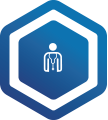
Inpatient Drug and Alcohol Treatment
Drug and alcohol addiction are both complex illnesses which are associated with uncontrollable, intense cravings, compulsive drug-seeking behavior, and substance use that poses serious consequences. The path to drug addiction often starts out as a voluntary action, but over time, the person’s ability to refrain from substances is compromised, and compulsive seeking and consuming the drug becomes a way of life. Prolonged drug exposure affects brain functioning, and addiction is a cognitive condition that alters several brain circuits, such as those related to motivation and reward, inhibitory behavior control, learning, and memory.
According to the Centers for Disease Control and Prevention (CDC), 3 percent of people over the age of 12 years reported the nonmedical use of a psychotherapeutic drug during the last month, and for adults over the age of 18 years, 13 percent reported being regular drinkers of alcohol. The Substance Abuse and Mental Health Services Administration (SAMHSA) reports that over 23 million teens and adults required drug abuse treatment in 2009.
Therapy offered in Inpatient Centers
The components of a comprehensive inpatient treatment program include assessment, planning, pharmacotherapy, behavior therapy, case management, substance use monitoring, support group attendance, and continued care. These facilities also offer legal and financial services, housing, transportation, medical care, educational support, and family services. Evidence-based approaches to addiction treatment will vary from program to program, but most include cognitive behavioral therapy or contingency management therapy, plus medications.
Behavioral therapies improve an addict’s communication, relationship, and parenting skills, along with certain family dynamics. These strategies for avoidance of drug cravings will teach the client how to prevent relapse by avoiding triggers that lead to drug use. Also, the addict attends group therapy that offers social reinforcement and helps encourage behavioral contingencies to promote abstinence from drug use and abuse.
Medications Used in Inpatient Treatment
Once admitted to an inpatient treatment center for drugs and/or alcohol addiction, the substance abuse professionals will use a series of behavioral and physical diagnostic criteria to determine if or not you suffer from a true addiction. The criteria for diagnosis include:
- ● Withdrawal symptoms when drug is stopped
- ● Inability to cease use of drugs
- ● Not being able to meet obligations at work
- ● Letting down friends and family
- ● Withdrawal symptoms occur when drug use is stopped
- ● Physical tolerance to the drug
- ● Compulsive use of the drug, even when harmful consequences occur
The prescribed medications include:
- ● Opioid addiction – Methadone, buprenorphine, and naltrexone.
- ● Nicotine addiction – Patches, lozenges, gum, and nasal spray.
- ● Alcohol addiction – Naltrexone, acamprosate, and disulfiram.
Resources:
Principles of Drug Addiction Treatment: A Research-Based Guide (Third Edition). Retrieved from: www.dragabuse.gov
CDC (2014). Illegal Drug Use. Retrieved from: www.cdc.gov
CDC (2012). Alcohol Abuse. Retrieved from: www.cdc.gov

